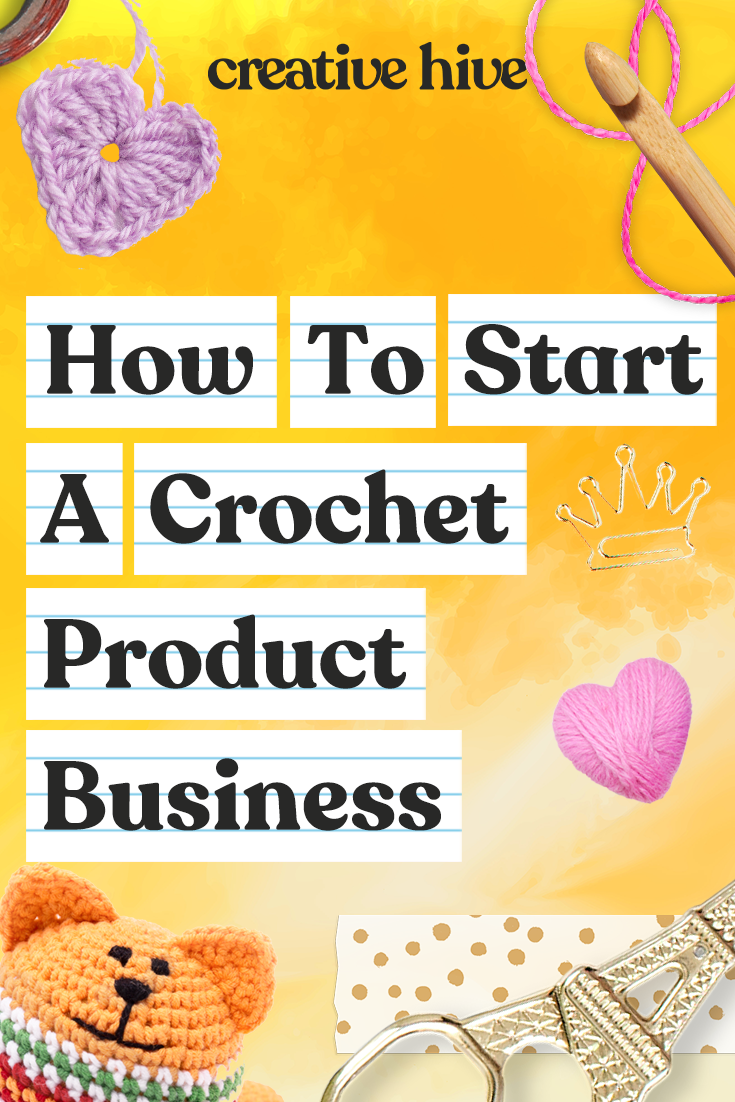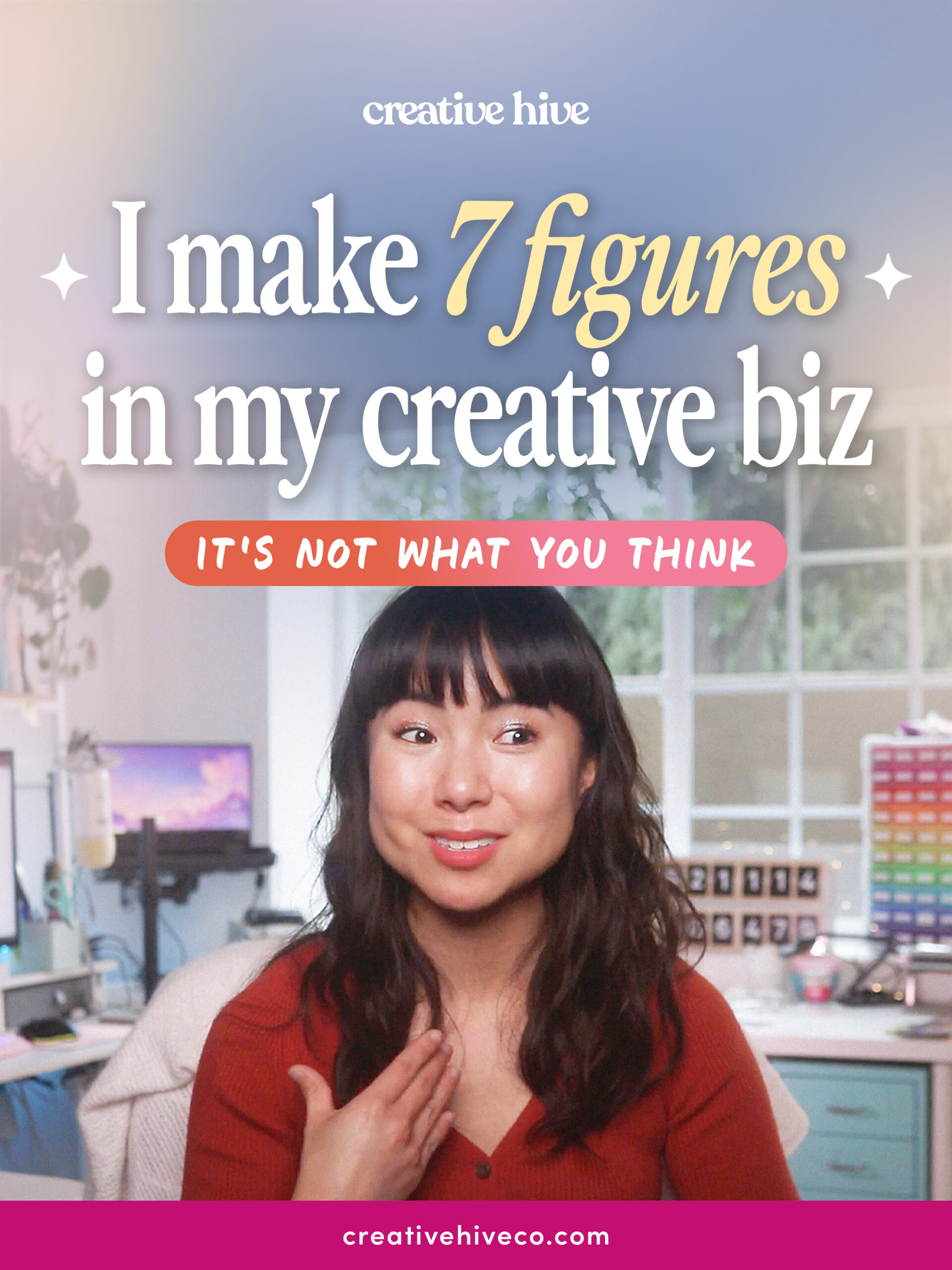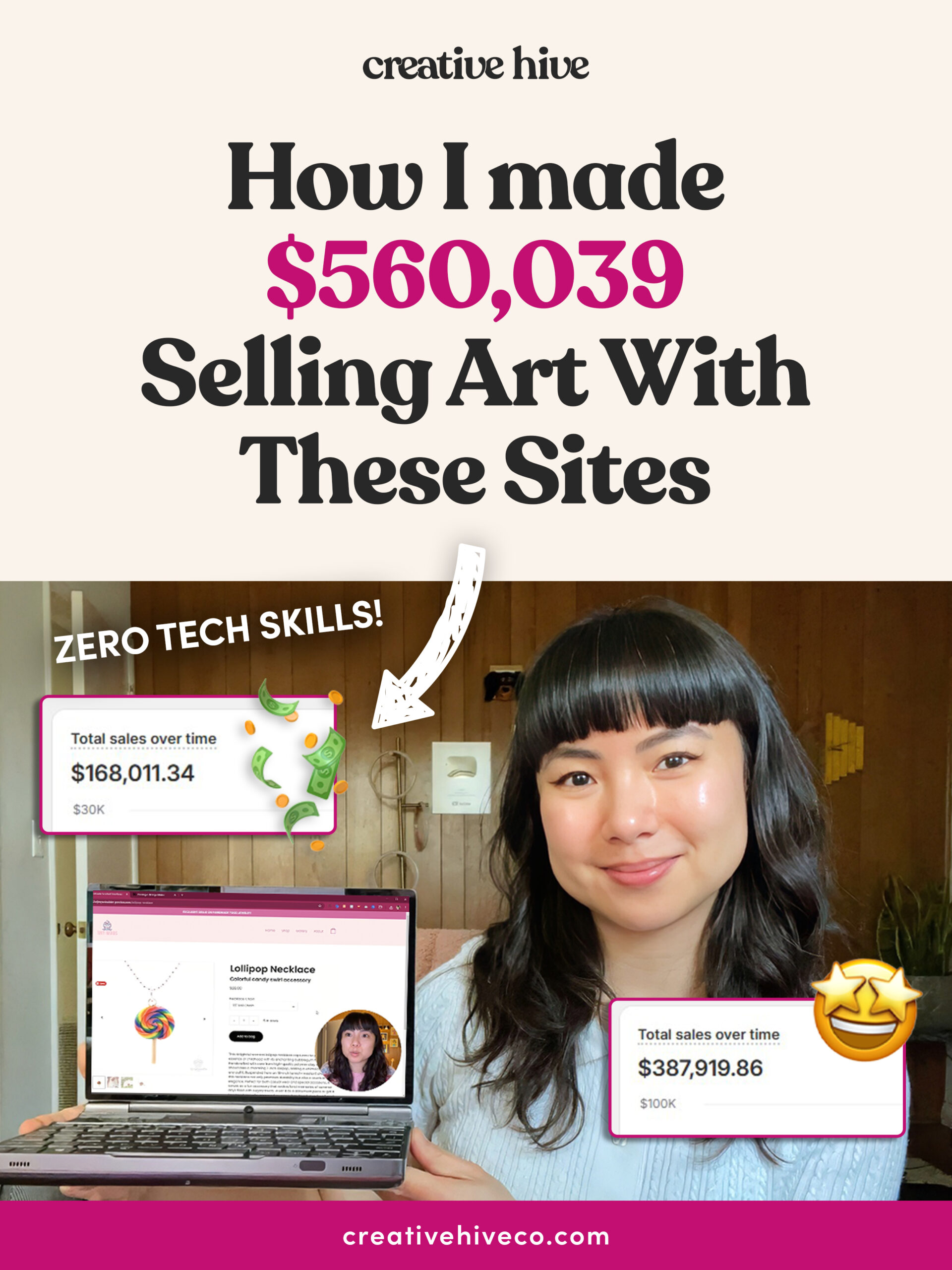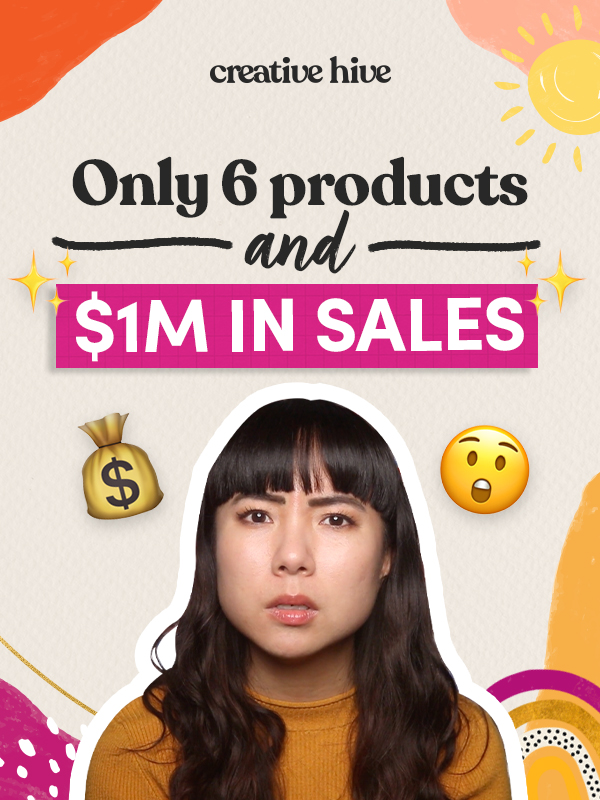I want to help you build a sustainable, profitable handmade business that makes you consistent income and sales. I only ever teach or recommend marketing, social media, pricing, production and branding tips that I’ve personally used successfully in my own 7-figure handmade businesses.
I'm Mei, from Los Angeles!
Read More
Popular Posts You'll Love
Looking for something?
Categories
starting a business
get more traffic
running a business
make more sales
branding
growing a business
mindset & productivity
podcasts
pricing & money
product photography
reviews
selling on etsy
selling on amazon
social media
selling wholesale
- Facebook0
- Twitter11
- Pinterest825
- 836shares
If you make crochet products and you want to sell them online and have a successful business doing that, read this post where I’ll show you how to start your own handmade crochet product business.
First, let’s talk about why your crochet business is a great idea
It’s not expensive to start a crochet business. You just need some yarn and a hook to get started! That’s much less expensive than say, starting a laser-cutting business that requires a $50,000 machine!
Crocheted items also have broad appeal. People in cold climates need hats, crocheted items are a very common traditional gift for babies and there’s the whole avenue of crocheted artwork.
On the whole, you’ll be pricing your items at a comfortable price point. That is, you aren’t trying to sell a $2,000 ring. You’re looking at items in the double-digits, which means that your items are likely to be accessible to a large audience.
Having said that, there are a number of challenges that you need to look out for
There are a lot of hobbyist crocheters out there who’re creating items and selling them for little more than the cost of the yarn. Because they aren’t running a business, they’re happy to just have fun and have their materials covered. They’re not making enough profit to make a living off of.
But if you’re running a business, not only do you need to be paid for your labor and profit, but you’re competing with all of these hobbyists.
It is a crowded marketplace and it can be a challenge, but don’t worry, I’ll talk about this issue more when I show you how to add your special sauce.
Crocheting is also time-consuming, compared to other production methods. Because you’re creating each item, stitch by stitch, there is going to be a limit on how many items you can make per week.
It’s going to be crucial that you select and design products that maximize your earnings.
Also, some customers perceive crochet as old-fashioned or not very valuable, and this is partially because it’s a very common hobby. That just makes it super-important that your branding is on-point.
Finally, you’ll want to think about the care of the final product. You may be happy hand-washing a wool sweater, but the average customer isn’t.
Choose your materials with the average customer in mind.
Let’s talk about the products that you’re going to stock in your shop.
This may sound completely obvious, but I’m going to say it anyway because I see a lot of business owners go wrong here. You need to offer products that people actually want.
If your items aren’t in demand, they aren’t going to sell.
This probably means you won’t be successful selling the easiest thing to make. It may not even be the first few ideas you come up with.
Once you have a few product ideas, you want to think about what they share in common so that your shop has a cohesive message.
What you don’t want is a shop that’s confusing with random stuff inside. This is what I call a garage sale shop.
No judgment here. I used to have a garage sale shop myself.
You definitely don’t want to just sell ‘stuff you crochet’. That isn’t a good enough theme in a competitive marketplace like we’re in now, especially if you’re trying to run a serious business.
Find a niche and develop it. Make sure that what you’re offering is awesome and something people want.
How do you find out what’s popular and what’s selling?
This is where Etsy comes in; it’s a great place to do research on what sells well.
You should, of course, never copy what other shops are doing. Etsy is an easy place to do your research, because so much of the information is public!
You can see how many sales a shop has, how long they’ve been in business, and how many times an item has sold.
Ideally, you’d stay away from a niche that’s completely flooded with low-cost competitors like Sugar n’Cream dishcloths.
You’d also want to really think hard before you offer something absolutely no one else is doing. Like adult-sized custom crochet costumes.
Maybe you’re the first person to have the idea and you’d be a total success, but more likely, it’s a sign that the idea wouldn’t really work. I’m not saying don’t go for it… but just really think about it.
Remember, you need to sell items that are in demand.
My guess is there aren’t enough people willing to pay you for the time it takes for you to crochet that custom adult-sized costume.
Alright, so you’ve narrowed down your product ideas
You’ve narrowed down your product ideas to items that you can make and that you’re pretty sure people want to buy. Now, let’s keep pushing a little bit more.
To be successful, you need to make sure your products stand out. I think of it as adding my own special sauce.
Your special sauce is what makes your products unique and different from everything else that’s out there.
It could be a little thing like:
- adding leather tags to finish off your pieces
- the quality of the yarn you use
- the designs you use
- you design your own pieces
Whatever it is, you want someone to be able to see your products and say, ‘that’s so-and-so’s’.
Your special sauce is the thing you become known for.
For example, when my friend, Stacey Trock, ran her crochet pattern company, FreshStitches, her designs were so distinctive that her customers could pick them out right away.
She told me that one time she did a design for a publisher which didn’t put her name on the pattern design and her customers wrote to her saying that the publishing company had stolen her pattern!
Her designs were that distinctive just from the style! That’s the look and definition a special sauce can give you.
Your special sauce could also be a combination of two different niches.
For example, I make scented food jewelry. I don’t just make any kind of jewelry. I make jewelry that looks like food.
I’m essentially combining the food niche and the jewelry niche into one.
Or take for example Twinkie Chan, who combines both crochet and food together, to make her food crochet products.
Okay, I hope you’re inspired by now. Just keep in mind that building a business takes a lot of time, so don’t expect all of this to happen overnight, ok?
Now, for your shop to be successful, you need to be able to earn enough money.
Let’s talk about pricing
I think the biggest challenge with selling finished crochet products is finding the balance between your product design, its price point, and people’s desire for what you make.
If you make something no one really wants to buy, then it doesn’t matter if you’ve spent 100 hours making the item.
The reality is that how much time you spend making something isn’t really going to make someone like your product more or less.
Even though I know as humans, we’re trained to think from a young age that if we spent more time on something, we deserved a better result, unfortunately, that’s not really true in business.
This doesn’t make it impossible to have a successful crochet business, but you just have to be extra careful with how you design your products.
Not only do you have to be extra cognizant of keeping the production process as labor efficient as possible, which probably means creating crochet products that are fast to make, but you also have to be thinking whether or not people value the item you’re making.
For example, the perceived value of a keychain is far lower than that of a scarf. So even though it’s probably faster and easier to make a small item like a crocheted keychain accessory, people probably aren’t willing to pay much money for a keychain.
You have to problem-solve for multiple factors here and make what I call smart design decisions from the get-go.
This is super important to know and is the difference between a five-figure business and a six-figure business.
Let’s talk about your materials and supply chain
I see a lot of crochet businesses buying their supplies retail. That is, they go to the craft store and buy their yarn at the same price everyone else pays.
This is a very hard way to run a profitable business.
When you purchase an item from a retail store, they take about half of the cost of the product so they can pay for their expensive overhead to keep their brick and mortar business going.
The prices you’re paying are a lot more than necessary.
That’s why, if you’re running a business instead of having a hobby, you’ll want to think about your supply chain.
If you’re purchasing significant quantities of yarn, you should be able to purchase it wholesale or at least at a discount from retail.
Try to go as straight to the source as possible with your other materials. Polyfill, leather tags and notions can all be purchased in bulk.
Take the time to find your sources and you’ll save big money in the long run!
A few of my recommendations are Knit Picks for yarn. It’s not wholesale pricing, but they’re the manufacturer, so their prices are on discount all the time. They don’t have minimum orders and they often run sales.
Brown Sheep, is another good source for yarn. Brown Sheep is an American Mill in the luxury yarn market. They have low minimum orders for product makers and at an accessible price point for the luxury yarn market. They also allow you to say ‘American made’ and point to the yarn origin as a selling point for your own products.
The Quilt Batting Store sells large quantities of polyfil if you’re a stuffed animal maker.
Also check out Shiny Happy World. You can get 50 pair packages of craft eyes at bulk pricing.
If you’re outside of the US or need a more specific material, contact a supplier you like to see if they offer wholesale pricing to business owners! Depending on the company, they might want just a tax ID number, some paperwork and a $300 minimum order.
That may sound like a lot to start, but if you plan your products the right way like selecting from a limited color palette, then you’ll be saving a lot of money!
Create a library of marketing materials
Once you’ve got all of that figured out, you’ll want to create a library of marketing materials that are going to help you make sales.
First, you want some great product photos. It’s good to have both product photos on a plain background as well as lifestyle photos, which are your items in real-life situations. Like, blankets on a bed, a hat on a baby or a stuffed animal in a pair of hands.
These photos are great for social media and they’ll also help you out with customer service.
Customers will miss a lot of information in your product descriptions, and if you don’t show your product in a real-life situation, you’ll inevitably get someone who thought your product was going to be a different size!
Next, you’ll want a logo. An easy and affordable way to make one is to head over to Creative Market or Fiverr. You can get either a template to use yourself or have someone else make you a simple one.
They’re surprisingly custom-looking and usually modern and on-trend but they’re probably made using a premade template!
You can also use these sites to create any packaging or print materials like business cards.
A template goes a long way. You don’t have to do everything from scratch!
You will of course also need to get your products up online somewhere. You have options like building up your own site on an ecommerce site builder like Shopify, or to sell on marketplace sites like Etsy and Amazon.
I recommend focusing most of your time on your own site, and when you have the time, set up on Etsy and Amazon. I have a whole video that talks about the pros and cons of these different options, so go check that out if you want a more in-depth explanation.
Once your business is open, it’s time to promote it!
If I were to start a business all over from scratch again today, and I had very limited funds, I would do media outreach.
Media outreach is reaching out to magazine editors, YouTubers, social media influencers, bloggers and anyone else who has a large following, and the goal is to get them to talk about or feature your products. This is a chance to get your work in front of hundreds of thousands of people.
If you want to get that kind of visibility, the other options you have are to pay money for paid advertising like with Facebook ads, or to slowly build our own following one follower at a time.
Can you imagine how long it would take you to build a following to a decent size where you’d make a meaningful income from?
It would take you years. Media outreach is a great shortcut.
Loads of successful online businesses have a track record of being featured somewhere prominent. This is the only thing I would attribute to being able to make a full time living with my jewelry business, Tiny Hands, and my coaching business, Creative Hive.
If you want to learn more about how to do media outreach, I have a video for that here.
Building a crochet business is not the easiest thing to do, but it’s totally possible as long as you’re considering all of these things.

Leave a Comment
Liked this article? Share it!
Unlock a Profitable Handmade Business
in Just 12 Weeks Without Using Etsy
or Social Media
FREE WORKSHOP
This workshop is for anyone who makes and sells a handmade or physical product, including jewelry designers, artists, paper designers, bath & body product makers and more!
What You'll Discover
The #1 mistake people make with Etsy & social media that causes shops to FLOP
The secret to making it with your handmade shop so it's no longer just a hobby
How to make sales in your handmade shop with ease so you can finally get to 6-figures
TAKE ME THERE
Your email address will not be published. Required fields are marked *
Leave a Reply Cancel reply
About
Blog
A Sale A Day
Student Login
Free Class
Contact
Terms
Become A Student
Watch On YouTube
Student Reviews
See My Handmade Shop!




Greate article, thank you so much.